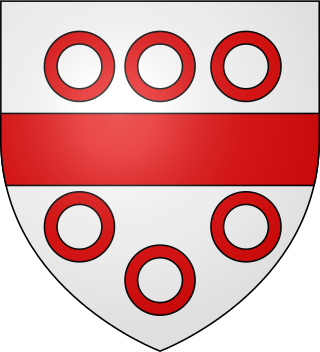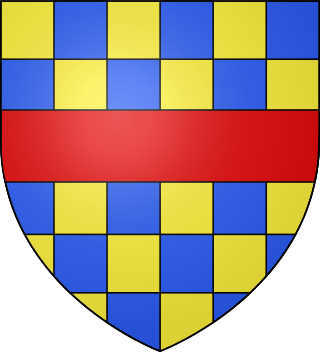
Earl of Cork is a title in the Peerage of Ireland, held in conjunction with the Earldom of Orrery since 1753. It was created in 1620 for Richard Boyle, 1st Baron Boyle. He had already been created Lord Boyle, Baron of Youghal, in the County of Cork, in 1616, and was made Viscount of Dungarvan, in the County of Waterford, at the same time he was given the earldom. These titles are also in the Peerage of Ireland.

Earl of Derby is a title in the Peerage of England. The title was first adopted by Robert de Ferrers, 1st Earl of Derby, under a creation of 1139. It continued with the Ferrers family until the 6th Earl forfeited his property toward the end of the reign of Henry III and died in 1279. Most of the Ferrers property and the Derby title were then held by the family of Henry III. The title merged in the Crown upon Henry IV's accession to the throne in 1399.

Baron Audley is a title in the Peerage of England first created in 1313, by writ to the Parliament of England, for Sir Nicholas Audley of Heighley Castle, a member of the Anglo-Norman Audley family of Staffordshire.

Duke of Northumberland is a noble title that has been created three times in English and British history, twice in the Peerage of England and once in the Peerage of Great Britain. The current holder of this title is Ralph Percy, 12th Duke of Northumberland.

Baron de Ros of Helmsley is the premier baron in the Peerage of England, created in 1288/89 for William de Ros, with precedence to 24 December 1264. Premier baron is a designation and status awarded to the holder of the most ancient extant barony of the Peerage of England. Before the Dissolution of the Monasteries the Prior of the Order of St John in England was deemed the premier baron.

The title Baron Percy has been created several times in the Peerage of England. The first, soon after 1066, a feudal barony rather than a barony by writ, which continued in parallel with the later baronies by writ, until the abolition of feudal tenure by the Tenures Abolition Act 1660. The second, created by writ in 1299, became extinct in 1517. The third, created by writ in 1557, became extinct in 1670. The present creation was in 1722, by writ of summons.
Baron Strabolgi is a title in the Peerage of England supposedly created in 1318 for Scottish lord David of Strathbogie, 10th Earl of Atholl. Despite lack of evidence supporting its existence, it was called out of abeyance by the House of Lords in 1916. Whether it ever existed before then is open to serious dispute.
The title of Baron Grey of Codnor is a title in the peerage of England.

Baron de Clifford is a title in the Peerage of England. It was created in 1299 for Robert de Clifford (c.1274–1314), feudal baron of Clifford in Herefordshire, feudal baron of Skipton in Yorkshire and feudal baron of Appleby in Westmoreland. The title was created by writ, which means that it can descend through both male and female lines. The Norman family which later took the name de Clifford settled in England after the Norman Conquest of 1066 and was first seated in England at Clifford Castle in Herefordshire. The first Baron served as Earl Marshal of England but was killed at the Battle of Bannockburn in 1314. His 8th generation descendant the 11th Baron, was created Earl of Cumberland in 1525, whose grandson the 3rd Earl was a noted naval commander. On the latter's death in 1605, the earldom passed to his younger brother, the 4th Earl.

Baron Wharton is a title in the Peerage of England, originally granted by letters patent to the heirs male of the 1st Baron, which was forfeited in 1729 when the last male-line heir was declared an outlaw. The Barony was erroneously revived in 1916 by writ of summons, thanks to an 1844 decision in the House of Lords based on absence of documentation. As such, the current Barony of Wharton could more accurately be listed as a new Barony, created in 1916, with the precedence of the older Barony.

Baron Lucas is a title that has been created twice in the Peerage of England. The second creation is extant and is currently held with the title Lord Dingwall in the Peerage of Scotland.

Baron Strange is a title which has been created four times in the Peerage of England. Two creations, one in 1295 and another in 1326, had only one holder each, upon whose deaths they became extinct. Two of the creations, that of 1299 and that of 1628, are extant. The surname Le Strange was Latinized as Extraneus. The arms of Le Strange of Knockin Castle in Shropshire were: Gules, two lions passant argent.

Baron Hunsdon is a title that has been created three times.
The hereditary peers form part of the peerage in the United Kingdom. As of November 2024, there are 801 hereditary peers: 30 dukes, 34 marquesses, 189 earls, 109 viscounts, and 439 barons.
The British peerage is governed by a body of law that has developed over several centuries. Much of this law has been established by a few important cases, and some of the more significant of these are addressed in this article.

Baron Clifford is a title in the Peerage of England created by writ of summons on 17 February 1628 for Henry Clifford, the heir of Francis Clifford, 4th Earl of Cumberland. Francis was believed to hold the Barony de Clifford, created in 1299, which could therefore be used to give Henry a seat in the House of Lords during his father's lifetime via a writ of acceleration. However, it would later be determined that the barony had in fact passed to his niece, Lady Anne Clifford. The summons of 1628 therefore unintentionally created a new barony, held by Henry. In 1641, on his father's death, Henry inherited the earldom of Cumberland, which became extinct upon his own death in 1643.
The title Baron Latimer or Latymer has been created, by the definitions of modern peerage law, four times in the Peerage of England. Of these, one was restored from abeyance in 1913; one is forfeit; the other two are dormant, although their heir is well known.

Baron Wentworth is a title in the Peerage of England. It was created in 1529 for Thomas Wentworth, who was also de jure sixth Baron le Despencer of the 1387 creation. The title was created by writ, which means that it can descend via female lines.
A writ in acceleration, commonly called a writ of acceleration, is a type of writ of summons that enabled the eldest son and heir apparent of a peer with more than one peerage to attend the British or Irish House of Lords, using one of his father's subsidiary titles, during his father's lifetime. This procedure could be used to bring younger men into the Lords and increase the number of capable members in a house that drew on a very small pool of talent.

In England, the baronage was the collectively inclusive term denoting all members of the feudal nobility, as observed by the constitutional authority Edward Coke. It was replaced eventually by the term peerage.